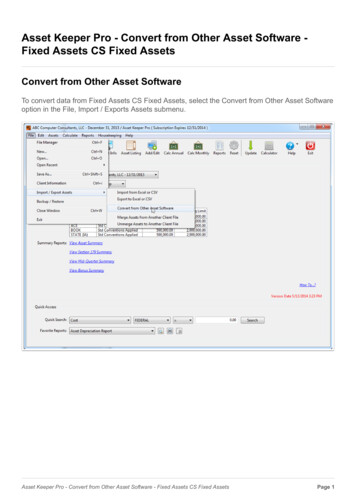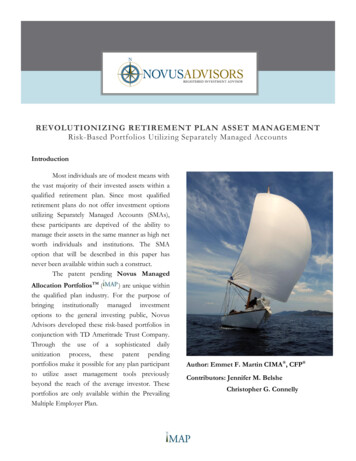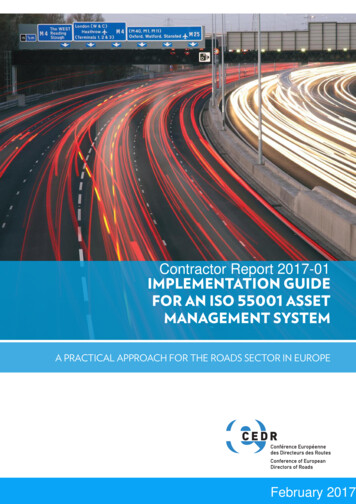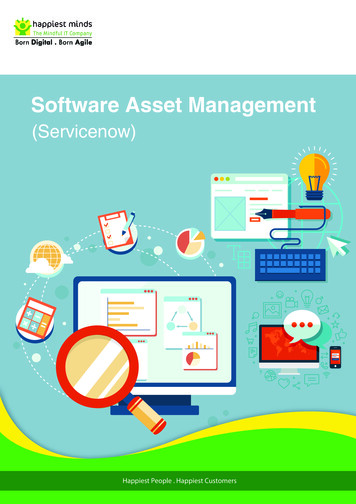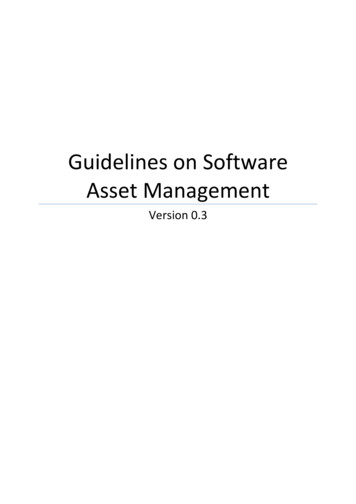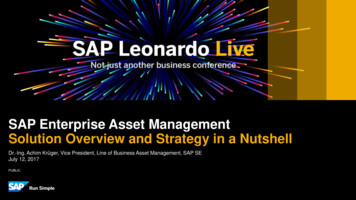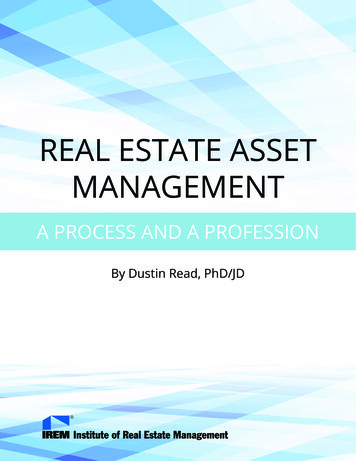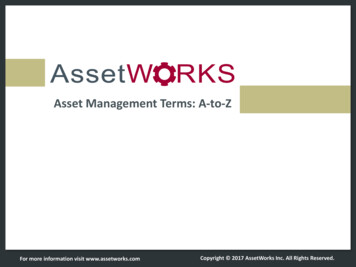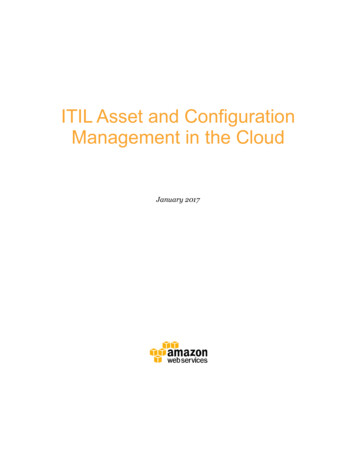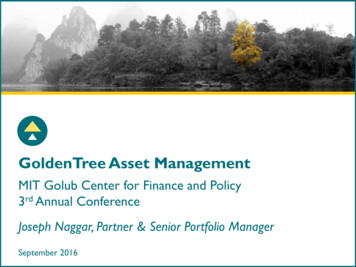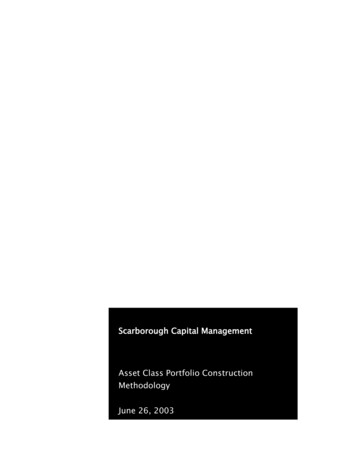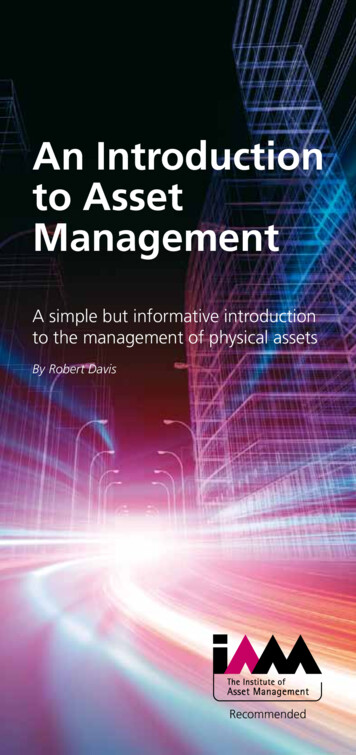
Transcription
An Introductionto AssetManagementA simple but informative introductionto the management of physical assetsBy Robert DavisThe Institute ofAsset ManagementRecommended
Published by blah d blah design ltdSubsidiary of EA Technology LtdCapenhurst Technology ParkCapenhurstChesterCH1 6ESwww.eatechnology.comCopyright Robert Davis978-0-9571508-3-6
ForewordAs the serving President of the Institute of AssetManagement, I am delighted to recommend thisshort book.As a past President of the IAM, Robert brought tothe subject of Asset Management his wealth ofexperience in business management and marketing.This helped enormously in developing the IAMand the field of Asset Management, from a purelyengineering and technical focus to one thatrecognises the need to engage across disciplines.Asset Management is increasingly well understood bythe business community as a strategic and businessled discipline, where the value of assets is theircontribution to achieving explicit business objectives.If you are encountering Asset Management for thefirst time, this book should be a helpful introductionto the key topics. It should also highlight the benefitswhich are there to be gained by understanding andapplying the fundamental principles. Of course, ifyou become interested or need to know more thereis a great deal to be explored and I look forward towelcoming you into our community!We are very grateful to Robert for making his bookfreely available and we would encourage you to passit on to anyone you think might benefit.Stephen MorrisPresident of the Institute of Asset Management1
An Introduction toAsset ManagementA simple but informative introductionto the management of physical assetsBy Robert DavisWe are all asset managers. The last time you hadyour car serviced or decorated your house, you weremanaging an asset!This book explores the discipline of AssetManagement and demonstrates how it can be usedto make better investment decisions.2
Do you work for a company that owns ormanages physical assets? Would you like towork for a utility? Or have you just heard theexpression ‘Asset Management’ and want toknow more about it? If the answer to any ofthe above is ‘Yes!’, then this book is for you.Why does Asset Management matter? Why isit useful? How does it improve organisationaleffectiveness? How will it help me as an engineer,accountant, operational manager or director?This book will address these issues and signpostyou to sources of information which can deepenyour understanding and help you on your AssetManagement journey.In writing this book, I have benefited from thewonderful intelligence and experience shared withme during my years as President of the Institute ofAsset Management by a number of world leadingexperts in the field, as well as drawing on my twentyyears plus experience of managing property, plantand equipment assets.I am indebted to the people who have generouslygiven their time to edit this document, including PaulBarnfather, Tom Elner, Madi and Deb Davis andJo Parker.For more information on the Institute of AssetManagement, go to www.theIAM.orgI can be contacted via:asset.management@eatechnology.com3
ContentsPage5.Introduction6.What do we mean by ’physical asset’?7.What Asset Management is .and isn’t10.Why is Asset Management important?11.The asset life cycle13.Understanding risk15.So what does an asset manager do?17.How good do you need to be?19.More detail the subject areas21.Glossary of Asset Management terminology25.Where to next ?4
IntroductionThe management of physical assets is like any otherevolving management discipline. It suffers fromterminology overload. The newcomer to the subjectmay struggle to understand the basics. This is partlybecause of the unfamiliar context, but also becausethere are still relatively few people around to ask!This book will give newcomers a starting point fromwhich to develop their knowledge. For those justpast the starting point, it might give some structureto their understanding. For the well-seasoned assetmanagers out there, I hope it provides either a feelingof satisfaction, or better still, grounds for a gooddiscussion!Managing assets effectively for utilities is not optionalthese days. Across the globe, every society is facedwith a significant asset management challenge: Emerging economies are trying to identify thelowest cost / highest return investments toachieve maximum immediate benefit Rapidly developing countries are faced withunderstanding the life cycle costs of theirinfrastructure More mature economies are trying to find waysof extending the life of their infrastructure andalso meet major global challenges like climatechangeAsset management thinking can provide structureto assist in all of these scenarios. It can improve thequality of life for millions of people. It is an importantcog in the big machine of our evolving civilisation.Done well, it impacts positively on the well-being ofthe planet and everything on it.5
What do we mean by’physical asset’?1. Dictionary Definition of Asset“Any item of economic value owned by anindividual or corporation”2. Why ‘physical’ asset?We ARE referring to items such as buildings,utility infrastructure such as electrical cables,water pipes, rail lines and metro tunnels, andindustrial assets such as oil rigs, chemical plantsand process plant conveyorsWe are NOT talking about financial assets,human assets or personal assets, as referred toin their normal context but we may be talkingabout non-physical things that affect thesephysical assets: skills, data, systems and software,for example3. Other features of a ‘physical’ asset include 6Its value may be represented on acorporation’s balance sheetIt may be listed in a register (asset repository,see glossary)Its value normally depreciates over timeIts condition normally deteriorates with timeand / or useIt is likely to benefit from good stewardshipIt plays some role or has a function in thedelivery of a process or serviceThere are often lots of similar items aroundthe globe which can benefit from similarmanagement
What Asset Managementis .and isn’t1. Asset Management: Is a mind-set which sees physical assetsnot as inanimate and unchanging lumps ofmetal / plastic / concrete, but as objects andsystems which respond to their environment,change and normally deteriorate with use,and progressively grow old then fail / stopworking / die! Is a recognition that assets have a life cycle Is as important for those working in financeas it is for engineers Is an approach that looks to get the bestout of the assets for the benefit of theorganisation and/or its stakeholders Is about understanding and managing therisk associated with owning assetsOne of the challenges with managing an asset isthat it is not sentient. It does not keep managementedicts. It does not respond to the economy or politics.But it does respond to how it is treated and used.This creates a challenge for management. How doyou get the right behaviour from an entity that won’tlisten?7
A key principle in Asset Management is LINE OFSIGHT that means: An approach within an organisation thatlooks to line up the work that is donedirectly on assets with the objectives of thatorganisation A discipline which recognises,accommodates and aligns the risk of owninga particular asset with the goals of theorganisation that operates the assetSome ExamplesEg.1. A good ‘asset management’ decisionmight be to purchase an expensive, highspecification stainless steel piping system withinan industrial process. Whilst the initial cost ishigher, the maintenance costs may be lowerand the expected life 3 times longer, the risk ofdisruptive failure may be lower and thereforethe risk to the organisation from a performance,health & safety and environmental perspectiveconsequently much lower. The total life cyclecosts, therefore, may be lower and the total riskto the organisation through purchasing the moreexpensive piping system therefore represents agood asset management decision.Eg.2. A poor asset management decision mightbe to reduce the frequency of maintenanceactivity on an asset without appreciating the fullimpact of doing so.Whilst there may be a short term financialbenefit, the long term cost to the organisation,if the asset prematurely fails, might substantiallyoutweigh this benefit. Of course, maintenanceis recognised as a means of introducing failures,so proper investigation may prove that reducingmaintenance frequency is a net benefit to theorganisation!8
2. Asset Management: Is not just about maintenance. Maintenanceis part of the stewardship of assets, butso is design, procurement, installation,commissioning, operation, etc. See adescription of the Asset Life Cycle later Is not a substitute for quality management.Asset Management, like other managementprocesses, should be subject to scrutinythrough a quality process to ensure rigour Is not a project management system Is not just for engineers. Everyone workingin a company that owns or operates assetsshould be interested. This includes thoseworking in procurement, finance, personnel,service, planning, design, operations,administration, leadership, marketing andsales Is not just an accounting exercise. Whilst itmay help you understand the deteriorationand hence depreciation of an asset, it is ofinterest to every part of the organisation Is not a purely academic discipline. Whilst itis a worthy subject for academic review andadvancement, it is primarily a pragmatic,hands-on subject9
Why Asset Management isimportantAsset Management is important because it can helporganisations to:1. Reduce the total costs of operating theirassets2. Reduce the capital costs of investing in theasset base3. Improve the operating performance oftheir assets (reduce failure rates, increaseavailability, etc)4. Reduce the potential health impacts ofoperating the assets5. Reduce the safety risks of operating theassets6. Minimise the environmental impact ofoperating the assets7. Maintain and improve the reputation ofthe organisation8. Improve the regulatory performance ofthe organisation9. Reduce legal risks associated withoperating assetsThe key to good Asset Management is that itOPTIMISES these benefits. That means that assetmanagement takes all of the above into account anddetermines the best blend of activity to achieve thebest balance for all of the above for the benefit ofthe organisation.Asset Management is explicitly focussed onhelping organisations to achieve their definedobjectives and to determine the optimal blendof activities based on these objectives.10
Asset life cycleThe AssetLife CyclenOpCommissioDisposeAcquireerateUnderstanding that assets have a life cycle is a keyconcept within Asset Management and is thereforeworthy of scrutiny.There are dozens of different ways of representingthe life cycle, but the diagram above capturesa simple representation of it. The arrows don’trepresent the length of time spent in each phase!1. AcquireThis covers everything the goes into planning,designing and procuring an asset. Some life cyclediagrams capture Planning as a separate function.Proper application of these activities ensures that theasset is fit for purpose.2. CommissionThis covers the activities of installing / creatingor building the asset and ensuring that it is fullyfunctional. It is a recognised fact that there is a higherincidence of failure after first installation / buildingof an asset (Infant Mortality, see glossary). This isreflected in the need for the commissioning stage inthe life cycle to oversee the initial operation of theassets.11
3. OperateThis is normally the bulk of the life cycle for an assetduring which it provides the function for which itwas designed. During this period the asset shouldbe subject to appropriate monitoring, maintenance,refurbishment and potential upgrade to meet anychange in condition or operational requirement.For many assets, this phase is decades long. It mayeven be centuries. It is the phase that many engineersare most familiar with.4. DisposeThis is often the most overlooked phase. Assets canlast beyond a human lifetime and it can be difficultto consider asset disposal when it is so far into thefuture. Asset Management teaches us that we ignoreany stage of the asset life cycle at our peril.This is a key period within an asset’s life. With someassets, e.g. in the nuclear industry, this can be anextended and highly critical period. Key activitiesduring this period include the effective removal ofthe asset from operation; the disposal or recyclingof the asset or its components; and the feed into the planning for the replacement asset (if areplacement is required) to determine the operationalrequirements based on the effectiveness of operationand the failure modes encountered.12
Understanding risk1. Dictionary definition of risk is:“(Exposure to) the possibility of loss, injury, orother adverse or unwelcome circumstance; achance or situation involving such a possibility.”2. The management of risk within assetmanagement is critical. Why? Because assetmanagers are responsible for OPTIMISINGoutcomes for the good of their organisation, andtherefore need to make judgements about whichactions best achieve the right blend of outcomesbased on organisational objectives.To make these judgements, they need to predicthow their actions will impact on the futureperformance of the assets. They need to quantifyboth the probability of their actions (or inactions)causing a change in performance and then theyneed to determine the impact or consequencesof that change in performance.Risk Probability X Consequence(of failure)(of failure)3. For example an asset manager is responsible formaintaining the building which houses somecritical electrical equipment. Water ingress intothe building would result in certain failure ofthe equipment and the consequence would bethat several thousand people would be withoutpower for a period of 24 hours. How does theasset manager quantify the risk associated withwater ingress? How does he/she determine thebest way to minimise the cost to the organisationwhile maintaining performance?continued.13
Two forms of potential water ingress exist: Leakage of rain water through the roof Flooding from a nearby riverRoofs of the type on the building have a design life of25 years and its current condition suggests that it islikely to leak in the next 5 yearsThe consequence in each failure mode is the same.The probability of the roof leaking is 25 timeshigher than the probability of the river flooding. Therisk associated with the roof leakage is therefore 25times higher. So the optimal mitigation to reducethe risk of failure of the electrical plant as a result ofwater ingress is to repair the roof! Easy!In the real world, we tend to focus on one solutionto manage risk: either manage the probability ormanage the consequences. These solutions oftenrest with different departments, different budgetsor even different organisations. The optimumreduction in risk comes when we identify where therisk is coming from and invest in and manage boththe probability and the consequences accordingly.Correctly addressing this challenge is at the heart ofasset management discipline.14
So what does an assetmanager do?Drawing on the Institute of Asset Management’sCompetences Framework, 2008 as a reference point,there are seven key activities that asset managers getinvolved in. It is important to understand that all ofthese activities overlap:1. Developing PolicyThe Asset Management Policy is the linkbetween the Organisational Plan (that is thetop level ‘business plan’ in a company) andthe Asset Management Strategy. It is typicallya set of principles or guidelines to steerAsset Management activity to achieve theorganisation’s objectives. It specifically covers the‘what’ and the ‘why’.2. Developing StrategyThe Asset Management Strategy directs theorganisation’s Asset Management activity; it willdetermine the high level Asset Managementobjectives that are needed from the activity todeliver the organisation’s objectives; it will definethe approach to planning that will be taken.3. Asset Management PlanningAsset Management Planning looks at consideringall the options for activities and investmentsgoing forward and then putting together a setof plans which describe what will be done whenand by whom. The asset manager ensures thatthe plan delivers what is required of it by thestrategy.4. Delivering the PlansThis is the bit where work is actually done on theassets, whether assessing or monitoring them,maintaining or repairing them, refurbishing or15
replacing them. This activity clearly needs toinclude the appropriate controls to ensure thework is done efficiently and that informationgathered is fed back into the strategy andplanning activities.5. Developing PeopleThis activity is specifically about developing theskills and competences of people to better deliverAsset Management activities. It spans from theboard room to the tool box and also throughthe supply chain. As well as individual skills, itlooks at the culture within an organisation andhow change can be managed to achieve optimalresults for that organisation.6. Managing RiskUnderstanding risk is a critical concept in AssetManagement and is a key function and area ofcompetence. Its focus is on being able to assessthe risk of action or inaction on the performanceof assets in the context of the organisation’scorporate objectives.7. Managing Asset InformationCollecting and collating the right information toinform Asset Management decisions is crucial toachieving Asset Management success. Too muchdata confuses the picture and costs money tocollect. Too little data results in decisions made inthe dark (or at best the twilight!).Ensuring that the right people have the rightinformation to make the best decisions is key.16
How good do you needto be?Asset Management eddingCompetentCompliancewith BSI PAS 55IntegratingAspiring“Beyond BSI PASS 55”OptimisingExellentLimit of knownAssetManagementBest PracticeThe Institute of Asset Management describes arange of ‘maturities’ of asset managers. It capturestheir skills, experience and level of development andtheir level of maturity compared to the BSI PAS 55standard, as shown in the diagram above.17
8. Good Asset Management practice advises thatyou should only be as sophisticated as you needto be. In other words, high levels of maturity inAsset Management practices for an asset basewhich is of low complexity and low criticality willattract unnecessary cost. Conversely, immatureAsset Management practices on complex orcritical asset bases introduces huge risk to anorganisation.Asset ComplexityLowHighThis concept is captured in the diagram below:CompetentSophisticated(PAS55)(Enterprise System)SimplisticCompetent(Paper Based)(PAS55)Asset CriticalityLow18High
More details the subject areasThe Institute of Asset Management has identifieda range of subject areas that justify furtherdevelopment and focus.Not every organisation will require excellence inevery one of these areas. Nevertheless, this is a veryuseful checklist and asset management organisationsshould, at the very least, consider what level ofcompetence is appropriate. Where necessary, skillsand expertise can be developed in the areas deemedcritical for a successful outcome.Asset Management Strategy and Planning Asset Management PolicyAsset Management StrategyDemand AnalysisStrategic PlanningAsset Management PlansAsset Management Decision-Making Capital Investment Decision-MakingOperations & Maintenance Decision-MakingLife Cycle Cost and Value OptimisationResourcing Strategy and OptimisationShutdowns & Outage Strategy and OptimisationAgeing Assets Strategy19
Lifecycle Delivery Activities Technical Standards & LegislationAsset Creation & AcquisitionSystems EngineeringMaintenance DeliveryReliability Engineering and Root Cause AnalysisAsset OperationsResource ManagementShutdown/Outage ManagementIncident ResponseAsset Rationalisation & DisposalAsset Knowledge Enablers Asset Information StrategyAsset Knowledge StandardsAsset Information SystemsAsset Data & KnowledgeOrganisation and People Enablers Contract & Supplier ManagementAsset Management LeadershipOrganisational Structure, Culture, Roles &ResponsibilitiesCompetence & Behaviour Risk & Review 20Criticality, Risk Assessment & ManagementContingency Planning & Resilience AnalysisSustainable DevelopmentWeather & Climate ChangeAsset & Systems Performance & HealthMonitoringAsset & System Change ManagementManagement Review, Audit and AssuranceAccounting PracticesStakeholder Relations
Glossary of AssetManagement terminologyAcquireBuy an asset based on proper understanding of its lifecycleAgeingGetting old, specifically beyond the design life of theassetAsset RegisterA central database of information about your assetsAsset RepositorySame as Asset RegisterAsset Information SystemsCan be paper based, but normally a software systemfor ensuring the right asset information gets to theright peopleAsset Management PlanA coordinated approach within an organisation todefine and deliver a set of actions towards achievingthe objectives set out in the Asset ManagementStrategyAsset Management StrategyThis defines the objectives of the Asset ManagementPlan in the context of the Organisational Plan, theAsset Management Policy and the approach that willbe adopted within the Asset Management Plan toachieve these objectivesAsset Management PolicyA set of guiding principles which steer the AssetManagement activity at a high level. It describes thegeneral approach to Asset Management, illustratingwhat is important to an organisation21
Bath Tub CurveAssets fail early in ‘life’ or later in ‘life’, and not sooften in the middleBalanced Score CardA standardised approach to assessing the value to anorganisation of different activities, e.g. maintenanceBenchmarkingComparing performance, often between companiesin similar sectorsBSI PAS55This is a publicly available specification seekingto define a standard approach to the AssetManagement discipline. Available from BritishStandards Institute or the IAMCapital ExpenditureMonies spent on equipment or plant which normallyfeature on a balance sheet as capitalCondition MonitoringAssessing an asset to understand how it is likely toperform in the futureConsequenceThis is the outcome or impact of an AssetManagement decisionDefectA fault in specification or performance of an assetDepreciationA reduction in value of an asset based on its age orconditionDisposeRemove asset from service and ensure it isappropriately recycled, buried, etcFault Tree AnalysisA graphical means of finding all of the potentialcauses of a fault22
FailureThe point at which an asset stops performing thefunction for which it was designedFailure ModeA way in which an asset stops functioningFMEA (Failure Mode Effects Analysis)A means of assessing how assets can fail and theimpact failure can have on the operation of the plantHealth IndexA single number which describes the overallcondition of an assetInfant MortalityThe occurrence of failure early in an asset’s lifeInterventionMaintenance, refurbishment, repair or disposal ofan assetKey Performance IndicatorsThose performance criteria against which the successof an activity is measuredLife CycleThe stages of an asset’s involvement with a company,from acquisition through commissioning andoperation to disposalMaintenanceAn intervention on an asset to improve its operationor ensure its continued good operationOperational ExpenditureMonies spent on activity which cannot be capitalisednormally associated with the servicing, conditionmonitoring and maintenance of an asset or servicePhysical AssetA tangible, man made object that has a specificfunction, normally within a broader systemPlan Do Check ActA systematic process which seeks to ensure quality aswell as continued improvement23
Preventative MaintenanceAn intervention on an asset taken in advance of afailure to reduce the chances of failureRCMReliability Centred Maintenance is an approach whichtargets intervention on assets based on the knownhistoric performance of that or similar assetsRepairAn intervention on an asset taken after it has failedRepair, renovate, refurbishAn intervention which improves the performance andcondition of an asset to upgrade or retain desiredperformanceReplaceSee Dispose aboveRiskThe potential for an adverse circumstance to ariseRisk FactorsThe categories or types of risk that may occur,e.g. relating to performance, health and safety,environmental, etcRoot Cause AnalysisA thorough assessment of all of the factorsinfluencing the occurrence of a fault or failureShutdown / OutageA period, either planned or otherwise, during whichasset interventions occurTime Based MaintenanceIntervention on an asset based on a prescribed timeperiod during which the work is to take placeWhole Life CostingAn understanding of the full economic impact ofowning an asset, covering all stages of its life cycle24
Where next .?1. The web site of the Institute of AssetManagement is a great place to start:www.theIAM.org2. BSI PAS55:2008. This is a publicly availablespecification which defines a standard approachto the Asset Management discipline. Availablefrom British Standards Institute or the IAM3. Asset Management Competences Framework.Available to members via the IAM website4. Asset Information Guidelines. Available tomembers via the IAM website5. BSI PAS55:2008 Assessment Methodology.Available to members via the IAM website6. Books: Asset Management: Whole-life Managementof Physical Assets, Chris Lloyd, et al Strategic Asset Management, the Quest forUtility Excellence, Clive Deadman7. Asset Management Council, Australia. Excellentglossary of asset management terms andevolving body of knowledge on their website25
Notes .
Notes .
The Institute ofAsset Managementthe professional body forwhole life management ofphysical assetsAbout the IAMThe Institute of Asset Management (IAM) is the independent, notfor-profit, membership organisation for those involved in acquisition, operation and care of physicalassets, particularly critical infrastructure; and professionals dedicated to furthering knowledge andunderstanding of Asset Management.Membership benefits Conferences, seminars and social events – with discounts topartner events‘Assets’ magazine – FREE to MembersPersonal learning and Continuing Professional Development(CPD)Projects to develop standards and guidance on best practiceand assessmentEndorsement of Training Providers and PAS55 ComplianceAssessorsAdvancement and promotion of knowledge andunderstanding of Asset Management everywherePromoting the development of external qualificationsDirectories and advertising on our website and Member-Onlyaccess to downloads and Knowledge CentreProfessional recognition (MIAM, FIAM accreditation forMembers and Fellows respectively)Our Objectives Advance the science and practice of Asset Management forthe public benefitPromote and recognise high standards of practice andprofessional competenceGenerate widespread awareness and understanding of thediscipline.Who should join?Professionals in any discipline who are involved in promoting anddelivering more effective Asset Management – whether in thepublic, private or academic sectors.Successful Asset Management requires a combination of skills,techniques and knowledge, particularly finance and we welcomeengagement and collaboration with other expert bodies andinterested individuals.Join UsYou can join as an Individual Member, and your company ororganisation can join as a Corporate Member. Membershipoptions, criteria and application details can be found on the IAMwebsite:Please visit us at www.theIAM.org
Want to Develop yourAsset Management Skills?Call EA Technology on0800 028 7243Outside the UK 44 (0) 151 347 2394and ask for Robert Davis, or emailasset.management@eatechnology.comAsset Management SpecialistsFor Over 45 YearsASSESSOR
978-0-9571508-3-6
Asset Management is increasingly well understood by the business community as a strategic and business led discipline, where the value of assets is their contribution to achieving explicit business objectives. If you are encountering Asset Management for the first time, this book should be a
